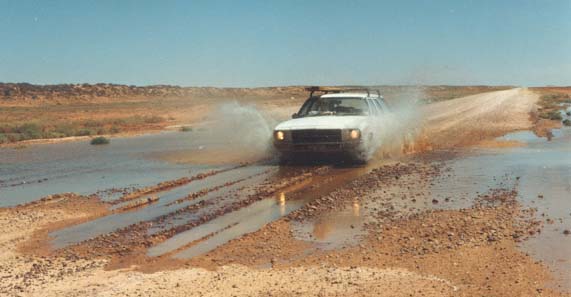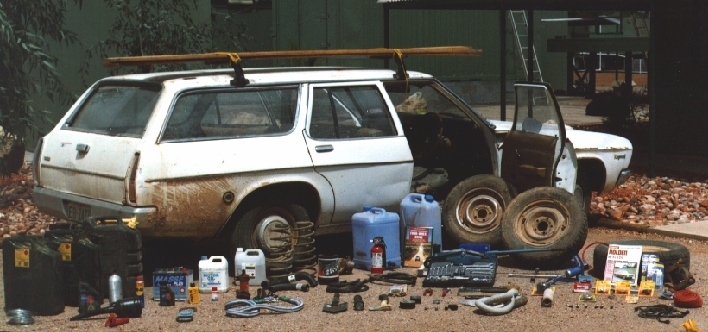Australian made |
THE HOLDEN HQ 202, 6 CYLINDER MODEL |
Australian made |
Australian made |
THE HOLDEN HQ 202, 6 CYLINDER MODEL |
Australian made |
Index:

 Introduction.
Introduction.
 Another picture of the Holden HQ.
Another picture of the Holden HQ.
 Technical aspects.
Technical aspects. Dimensions and Performance.
Dimensions and Performance.
 References
References
 Back to the Aussie desert page
Back to the Aussie desert page
 To the Desert Tracks.
To the Desert Tracks.
INTRODUCTION or back to Index
During my stay in Australia I became aware that distance, although the translation in Dutch is theoretically the same, in practice has a total different meaning. Distance in Australia is driving 300 km before you cross the next petrol station to fill up your petrol tank. This is the distance in distance not the distance in time, although Australia has an intensive interstate highway project called the Federal Government Building better roads, a lot of the Australian roads are still unsealed dirt roads, gravel roads or vehicular tracks. These roads can be in good shape, but one shower will change a hard surface of an unsealed road into a off road rally track! Average speeds of 100 km an hour or more are figures for Europe but not in Australia, if the weather is co-operative 50 km an hour is an achievement. People say you must drive 100 km as 10 km for getting the idea of “He I'm really moving”. Another unpredictable thing of unsealed roads is severe “lose gravel” and corrugations which will give almost the same characteristics as driving on “black ice” and makes your vehicle unhandable. Anybody who has driven real distances on dirt roads will experience this with the consequence of “parking his car on the roadside” or driving into a creek and wait until somebody comes along to pull you out. As a consequence of the facts mentioned above I decided that I definitely needed a car to spend my spare time and give me optimal opportunities to undertake some country trips. The solution is to buy a state of the art 4 WD, unfortunate out of reach for a Dutch Aquaculture student. An old Japanese car maybe? No, they wont hold long on dirt roads as they are to fragile (The first pothole will deliver a broken axle). So I came to the pride of the Australian car industry: The Holden Kingswood! This robust car is the best opportunity to travel through Australia after a 4 WD. Sometimes your even better of with a Holden than a modern 4 WD, especially with breakdowns, because spare parts are easy to obtain from other Kingswood’s resting in peace along the roads. The decision was made: I bought a 23 year old Holden Kingswood HQ Wagon. To keep this car on the road and to help myself during a breakdown I had to learn some technical knowledge about this car. The following is a short description of the HQ model, I wrote it down for my personal interest.
 |
The Holden Kingswood HQ series was first released in July 1971 and contained a 202 engine. This engine a six cylinder overhead valve in line engine has an iron cylinder head and one piece cylinder block and crankcase. The pistons are tin plated aluminium, relieved on the sides of the skirt in line with the gudgeon pin with strut reinforcement, and cross slotted between the skirt and the upper section of the piston. The valves are operated by hydraulic tappets and tubular push rods to individual pressed steel rocker arms, which pivot on a rocker arm pivot. Each hydraulic tappet, apart from acting as a com follower, also provides automatic adjustment of the valves by maintaining the valve lash at zero. Each cylinder has a bore of 3.625 in and a stroke of 3.250, which gives it a capacity of 3310 cc and a compression ratio of 9.4:1 (Volume combustion chamber at BDC/ volume TDC. The engine produces 135 hp at 4400 rpm and a maximum torque of 194 lb/ft (263Nm) at 2000 rpm, which will deliver a maximum power of 1010 N per wheel ((263*3.07)=(gear ratio))/0.4(wheel diameter))/2 = 1010 N.Index
The inlet and exhaust manifolds are separate units. The inlet manifold is of aluminium alloy and has a water heated area below the carburettor mounting flange connected by pipes to the thermostat housing. Positive crankcase ventilation recycles crankcase vapours via a ventilation valve into the inlet manifold. The carburettor installed is a Bendix-Stomberg BXUV-2. The Bendix-Stromberg carburettor fitted in this engine is a single throat, down draught type and has three sub assemblies listed below:
a)
The top cover, which houses the choke assembly and economizer jet vacuum
piston and the anti percolation (vent) valve.
b)
The main body, housing all the jets, the float assembly, the accelerator
pump and valves. The main metering jet has a diameter of 0.065 in and the
venture diameter is 1.218 in.
c)
The throttle valve body, which also incorporates the idle adjusting screw.
A
small spring loaded valve is incorporated in the choke butterfly valve
to prevent over choking when starting from cold.
The
carburettor is fed with patrol by a mechanical fuel pump driven by the
camshaft of the engine. Index
The ignition system used in the Holden is a mechanical one developed Bosch and contains of a coil, a contact breaker point assembly, a condenser, distributor, ignition leads and the spark plugs. The timing of the ignition is of most importance, the timing must be set that the contact breaker points must open so that the spark plug will fire just before the piston reaches the Top Death Center (TDC) on the compression stroke. The timing can be checked with a timing light. The distributor distributes the spark over the different cylinders and is powered by the cam shaft. Also important is the point gap (0.5 mm) and spark plug gap (0.9 mm). The timing advance is arranged by a vacuum advance device regulated by the vacuum measured in the carburettor. A higher vacuum achieved by an increased air demand of the engine will appear with higher rpm. As the engines rpm increases, the spark must be conducted to spark plug earlier, otherwise the piston will be on its way down again before the force of the exploding mixture can exert full pressure on it. The maximum pressure should be there between 10 and 20 degrees after TDC. The time it takes to the fuel mixture to explode is 0.003 seconds. At 1000 rpm, this is 18 degrees of crankshaft movement and at 2000 rpm it is 36 degrees. Index
The cooling system is a thermo-simphon type with fan and water pump assistance. The cooling system is pressurized in order to raise the boiling point of the coolant and so increase the efficiency of the engine. A provision is made to drain the radiator and the cylinder block. The fan and the water pump are driven by a V-belt from the crankshaft. This belt also drives the Bosch alternator. Temperature in the cooling system is controlled by a thermostat located in the cylinder head water outlet pipe housing, which starts to open between 81 - 83 degrees Celsius and is fully open at 94 degrees Celsius.Index
A clutch will transport the power produced by the engine to the gear box. The single dry plate clutch, diameter 8.625 in, is fitted with a diaphragm spring, pressure plate and cover assembly, which is operated mechanically with a fork push rod and is has to be adjust manually. The manual transmission contains of a three speed gearbox with synchromesh on all forward gears. The ratios ( Number of teeth driven/ number of teeth driving) are as follows: Top 1.00:1, Second 1.68:1, First 3.07:1 and the Reverse 3.59:1. All gears, except those in the reverse train, are helical cut. The reverse train employs straight spur type gears. The gearbox will elevate the power via a main shaft to the differential of the rear axles. The rear axles are of the floating type with flange mounted wheel hubs and hypnoid final drive gears. The differential can be of the limited slip type. The limited slip differential differs from the standard differential only in respect of the inner components. This differential carries out all the functions of the normal differential and in addition transfers the driving force to the wheel with traction if the other wheel should spin in the mud, ice or loose sand.Index
The steering gear is the worm and recirculating ball and nut type in which the ball nut mounted on the worm is driven through steel balls which functions as a rolling thread, circulating in grooves on the nut and the worm.
The
independent front suspension unit consist of upper and lower wishbone assemblies
with a coil spring and a telescopic single action shock absorber. The wishbones
are fitted with two steel backed rubber type bushes on their inner ends.
Both wishbones pivot on their inner ends on these bushes. The rear suspension
on the rear axle is located by four trailing arms and sprung by coil springs
and telescopic shock absorbers as well. The angled upper arms provide lateral
location and also share in controlling axle reactions to drive, braking
and acceleration forces. The lower, longer arms hold the axle square to
the vehicle and also share in controlling axle reactions to drive, braking
and acceleration forces.
A
hydraulically operated foot brake operates on front disc brakes and rear
drum brakes. The bores on the front wheels are larger than those of the
rear wheel cylinders to give a higher percentage of braking effect on the
front wheels. A tandem master cylinder provides two hydraulic fluid reservoirs
and separate hydraulic systems for the front and rear brakes. Check valves
are installed at each outlet port in the master cylinder in order to maintain
a residual pressure in the pipes and wheel cylinders. The front reservoir
and outlet is connected to the front wheel brakes and the rear reservoir
and outlet is connected to rear brakes. This ensures that a failure in
the front brakes will not render the rear brakes inoperative and vice versa.
Index.
THE CAR: DIMENSIONS AND PERFORMANCE or back to Index
The HQ has a chassis construction with a wheel base of 2820 mm, a front track of 1511 and a rear track of 1530 mm. The length, width and height of the car are resp 4852 mm, 1885 mm and 1374 mm. The weight is 1445 Kg and the ground clearance of the car is 152 mm. The 135 Hp engine will bring the car from 0 -60 mph in 13.4 sec and will give a top speed of 90 mph. The fuel consumption lies between 22-25 mpg (miles per gallon).
REFERENCES or back to Index
-General
Motors - Holden PTY LTD (1985). Motor Vehicle Engines Part 1 and 2. Curriculum
Branch, education department of Western Australia. 162pp.
-Gregory’s
(1977), Holden HQ-HJ 6 cylinder service and repair manual. Third edition,
scientific publications No 146, Sydney Australia. 222pp.
or Back to the Aussie desert page